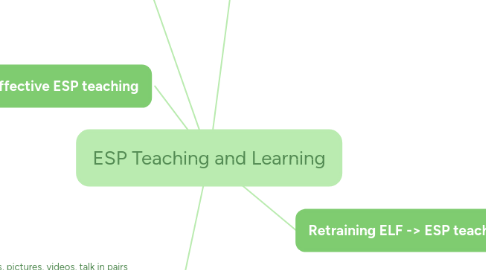
1. Objectives
1.1. Reveal subject-specific language use
1.1.1. How the language is used in the target setting
1.2. Develop target performance competencies
1.2.1. What learners do with language and the needed skills to be competent
1.3. Teach underlying knowledge
1.3.1. Sss field's of study or work besides their language skills
1.4. Develop strategic competence
1.4.1. Link between context of situation and language knowledge
1.5. Foster critical awareness
1.5.1. Ss' consciousness and cultural awareness of the target situation
2. Learners
2.1. Concrete: games, pictures, videos, talk in pairs and practice E outside of the class
2.2. Analytical: grammar, E books, study alone, find their own mistakes
2.3. Communicative: listen to native speakers, use E out of class, learn by conversation
2.4. Teacher-oriented: teacher explains everything, learn words by reading and seeing them
3. Effective ESP teaching
3.1. Acquire relevant knowledge about students and use that knowledge to inform our course design and classroom teaching
3.2. Articulate explicit expectations regarding learning objectives and policies
3.3. Prioritize the knowledge and skills we choose to focus on
3.4. Recognize and overcome our expert blind spots
3.5. Adopt suitable teaching roles to support our learning goals
3.6. Progressively refine our courses based on reflection and feedback
3.7. Align the three main components of instruction: learning objectives, assessments, and instructional activities
4. Retraining ELF -> ESP teachers
4.1. Selection, initial, terminal
4.1.1. Adequate enough to continue responsibility to teaching career
4.2. Continuing personal education
4.2.1. Personal education
4.2.2. Professional education
4.3. General professional training as an educator/teacher
4.3.1. Educational psychology, the study of children development
4.3.2. An outline of the organization of education in a particular country
4.3.3. An awareness of the moral and rhetorical function of teachers
4.3.4. Class management, instructional techniques
4.4. Special training as a teacher of a foreign/second language
4.4.1. Skills components
4.4.2. Information component
4.4.3. Theory component
5. Teaching strategies
5.1. Input-based
5.1.1. Predominantly input
5.1.1.1. Learning occurs primarily through exposure to samples of language use. No explicit instruction from teachers.
5.1.2. Input-to-output
5.1.2.1. Ss are provided with input, notice the language forms and features.
5.2. Output-based
5.2.1. Predominantly output
5.2.1.1. Learners are placed in the situations that require them to perform production tasks at the outset of a lesson.
5.2.1.2. Learning occurs through students struggling to communicate and being pushed to reach their linguistic ceilings.
5.2.2. Output-to-input
5.2.2.1. Learner's production (output) is followed by feedback (Ss perform a task and feedback is provided to show a more native-like performance. During production, Ss experience a hole in linguistic repertoire and are offered a solution in the form of feedback)

